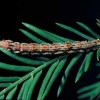Abstract
Anacamptodes pergracilis (Hulst), commonly known as the cypress looper, drew considerable attention in late summer of 1980 with the unexpected defoliation of nearly 28,000 ha of cypress trees in USFS-NPS Big Cypress National Preserve (Collier and Monroe counties). Currently, cypress looper populations are at low levels, even in the Fisheating Creek (Glades County) area, a perennial generator of significant cypress looper defoliation over the past 20 years. This 3-page fact sheet was written by Wayne N. Dixon and published by the UF Department of Entomology and Nematology, April 2013.
References
Carothers WA, Ghent J. 1980. Biological evaluation of the cypress looper outbreak in the Big Cypress National Preserve in Florida. USFS-S&PF, SE Area, Atlanta, Georgia. Report 81-1-14. 17 p.
Kimball CP. 1965. Lepidoptera of Florida. Florida Department of Agriculture, Division of Plant Industry, Arthropods of Florida and Neighboring Land Areas 1: 1-363.
Rindge FH. 1966. A revision of the moth genus Anacamptodes (Lepidoptera: Geometridae). Bulletin of the American Museum Natural History 132: 178-243.
Wilkening A. 1980. Report on Anacamptodes rearing project. University of Florida, Department of Entomology and Nematology, Gainesville, Florida. 12 p. (unpublished).
Williston HL, Shropshire FW, Balmer WE. 1980. Cypress management: a forgotten opportunity. USFS-S&PF, SE Area, Atlanta, Georgia. Forestry Report SA-FR8. 8 p.
Unless otherwise specified, articles published in the EDIS journal after January 1, 2024 are licensed under a Creative Commons Attribution-NonCommercial-NoDerivs 4.0 International (CC BY-NC-ND 4.0) license.

